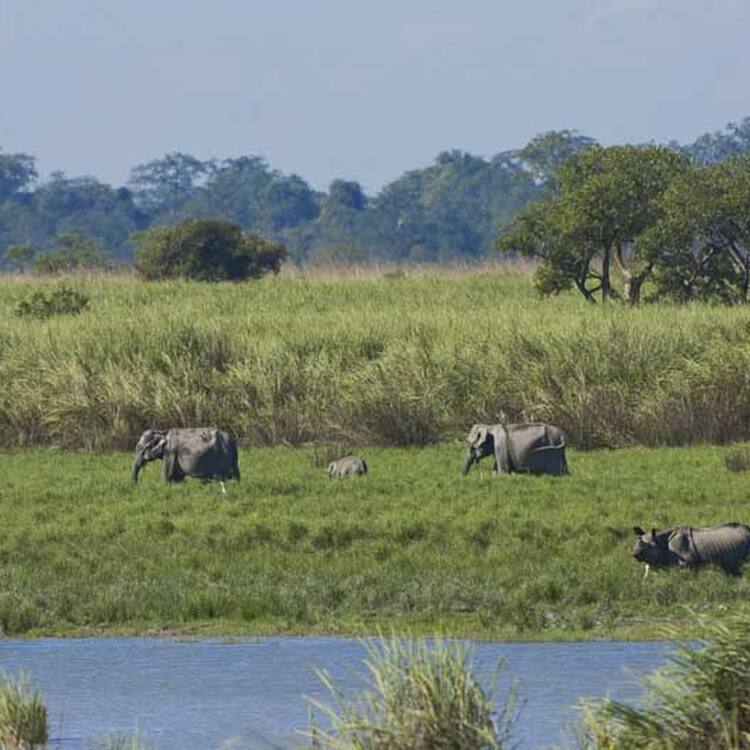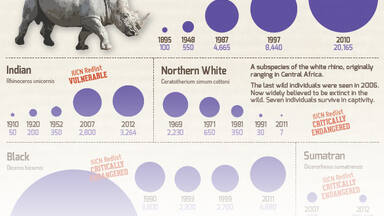Kaziranga National Park
Kaziranga National Park
In the heart of Assam, this park is one of the last areas in eastern India undisturbed by a human presence. It is inhabited by the world's largest population of one-horned rhinoceroses, as well as many mammals, including tigers, elephants, panthers and bears, and thousands of birds.
Description is available under license CC-BY-SA IGO 3.0
Parc national de Kaziranga
En plein cœur de l'Assam, le parc de Kaziranga, l'une des dernières zones de l'Inde du Nord qui n'aient pas été modifiées par l'homme, abrite la plus importante population de rhinocéros unicornes du monde, ainsi que de nombreux autres mammifères – tigres, éléphants, panthères, ours – et des milliers d'oiseaux.
Description is available under license CC-BY-SA IGO 3.0
روضة كازيرانغا الوطنية
يضمّ منتزه كازيرانغا الذي يقع في ولاية آسام وهو أحد آخر مناطق الهند الشمالية التي لم يغيرها الإنسان أهمّ سلالة وحيد القرن في العالم، بالإضافة إلى ثدييات عديدة أخرى كالنمور والفيلة والفهود والدببة وآلاف العصافير.
source: UNESCO/CPE
Description is available under license CC-BY-SA IGO 3.0
卡齐兰加国家公园
卡齐兰加国家公园位于印度阿萨姆邦中心地带,是印度东部最后一批没有人类活动骚扰的地区之一。这个公园里生活着世界上最大种群、最多数量的独角犀牛,还有许多其他哺乳动物,包括老虎、大象、豹、熊和数以千计的鸟类。
source: UNESCO/CPE
Description is available under license CC-BY-SA IGO 3.0
Национальный парк Казиранга
Этот парк, расположенный в центре штата Ассам, является одной из немногих в восточной Индии областей с нетронутой человеком природой. Здесь обитают однорогие носороги (самая крупная в мире популяция этого вида), тигры, слоны, пантеры и медведи, а также отмечены огромные скопления птиц.
source: UNESCO/CPE
Description is available under license CC-BY-SA IGO 3.0
Parque nacional de Kaziranga
Situado en el corazón del Estado de Assam, este parque abarca una de las pocas zonas de la India septentrional que no han sufrido alteraciones por la presencia del ser humano. Posee la población de rinocerontes de un solo cuerno más numerosa del mundo, así como muchos otros mamíferos –tigres, elefantes, panteras y osos, etc.– y miles de aves.
source: UNESCO/CPE
Description is available under license CC-BY-SA IGO 3.0
カジランガ国立公園
世界の最多雨地帯アッサム盆地を流れる、インド第2の大河ブラフマプトラ川。この川筋の移動と土砂の堆積の跡に広がる平野にこの国立公園は位置する。ここはインドサイの絶好の生息地で、また、インド象、虎、水牛、ペリカンなども生息している。インドサイの生息数は現在地球上で2000頭ほどでそのうち1200頭がこの地にいる。source: NFUAJ
Nationaal park Kaziranga
Dit nationaal park ligt in het hart van Assam. Het is een van de laatste gebieden in Oost-India die niet door menselijke aanwezigheid wordt verstoord. Het park wordt bewoond door ‘s werelds grootste aantal éénhoornige neushoorns en veel andere zoogdierensoorten, zoals tijgers, olifanten, panters en beren. Het gebied ligt op de zuidoever van de (rivier) Brahmaputra, aan de voet van de Mikir heuvels. De talloze waterplassen in het park zorgen voor een rijke voedselvoorziening en duizenden trekvogels – meer dan 100 soorten – komen seizoensafhankelijk op bezoek. De vogels komen overal vandaan, zelfs uit Siberië.
Source: unesco.nl
काजीरंगा राष्ट्रीय उद्यान
असम के मध्य में, यह उद्यान पूर्वी भारत के उन अंतिम क्षेत्रों में से एक है, जो मानवीय उपस्थिति से अछूता है। यहां दुनिया में सबसे अधिक एक सींग वाले गैंडों के साथ-साथ बाघ, हाथी, तेंदुओं और भालू और हजारों पक्षियों सहित कई स्तनधारियों का निवास है।
Source: India
Outstanding Universal Value
Brief synthesis
Kaziranga National Park represents one of the last unmodified natural areas in the north-eastern region of India. Covering 42,996 ha, and located in the State of Assam it is the single largest undisturbed and representative area in the Brahmaputra Valley floodplain. The fluctuations of the Brahmaputra River result in spectacular examples of riverine and fluvial processes in this vast area of wet alluvial tall grassland interspersed with numerous broad shallow pools fringed with reeds and patches of deciduous to semi-evergreen woodlands. Kaziranga is regarded as one of the finest wildlife refuges in the world. The park’s contribution in saving the Indian one-horned rhinoceros from the brink of extinction at the turn of the 20th century to harbouring the single largest population of this species is a spectacular conservation achievement. The property also harbours significant populations of other threatened species including tigers, elephants, wild water buffalo and bears as well as aquatic species including the Ganges River dolphin. It is an important area for migratory birds.
Criterion (ix): River fluctuations by the Brahmaputra river system result in spectacular examples of riverine and fluvial processes. River bank erosion, sedimentation and formation of new lands as well as new water-bodies, plus succession between grasslands and woodlands represents outstanding examples of significant and ongoing, dynamic ecological and biological processes. Wet alluvial grasslands occupy nearly two-thirds of the park area and are maintained by annual flooding and burning. These natural processes create complexes of habitats which are also responsible for a diverse range of predator/prey relationships.
Criterion (x): Kaziranga was inscribed for being the world’s major stronghold of the Indian one-horned rhino, having the single largest population of this species, currently estimated at over 2,000 animals. The property also provides habitat for a number of globally threatened species including tiger, Asian elephant, wild water buffalo, gaur, eastern swamp deer, Sambar deer, hog deer, capped langur, hoolock gibbon and sloth bear. The park has recorded one of the highest density of tiger in the country and has been declared a Tiger Reserve since 2007. The park’s location at the junction of the Australasia and Indo-Asian flyway means that the park’s wetlands play a crucial role for the conservation of globally threatened migratory bird species. The Endangered Ganges dolphin is also found in some of the closed oxbow lakes.
Integrity
The perimeter of Kaziranga on three sides is adjacent to human settlements leading to challenges in protecting the site from illegal incursions of poachers and herdsmen. The introduction of rinderpest and domestic buffaloes has had negative effects on the wild water buffalo population, including hybridisation and genetic swamping of the remaining wild stock. Poaching of rhino has been a serious problem but the overall population levels are steady or rising. Another issue is seasonal flooding which causes many animals to migrate outside the park where they are susceptible to hunting and reprisal for crop damage. The presence of the busy national highway No. 37 along the southern border of Kaziranga has brought increased settlements which disturb wildlife movements in this landscape. While river migration has also resulted in the loss of some 5,000 ha of forest land from 1925 to 1986, the national park has been enlarged to the north to include part of the River Brahmaputra, although this area has not yet been proposed for inclusion within the World Heritage property. Maintenance of functional connectivity between the park and Karbi Anglong Hills, and the formation of a buffer zone to the south of the park would greatly add to the integrity of the park.
Protection and management requirements
The property receives the highest legal protection and strong legislative framework under the provisions of the Indian Wildlife (Protection) Act, 1972 and Indian Forest Act, 1927/Assam Forest Regulation 1891. The park has a long history of protection for over a century, reflected in the dramatic recovery of the rhino. The park has been declared as a Tiger Reserve in 2007 and there have been six additions to the park area which has improved management and protection efforts. The property benefits from government support at both national and regional levels as well as involvement of national and international conservation organisations. The site is managed under the administration of the Assam Forest Department, guided by a legally approved Management Plan. The present state of protection and conservation of the property is regarded as one of the best in India. However, key threats include rhino poaching, riverbank erosion, invasive species, tourism pressure, heavy highway traffic, and livestock grazing (particularly in the areas which have been added to the park). The management needs a long-term strategy for dealing with tourism-related issues, research and monitoring for habitat and wildlife, human-wildlife conflicts and boundary issues relating to the addition areas to the national park. In order to ensure sustained financial flows which are essential for the functioning of the park, the constitution of the Kaziranga Tiger Conservation Foundation has been a landmark measure. The management has also taken steps towards improving infrastructure and staff welfare provisions. Strengthening institutional linkages with other government departments and line agencies for the benefit of the local communities in the fringe villages around the property remains an important management objective for the park authorities.



